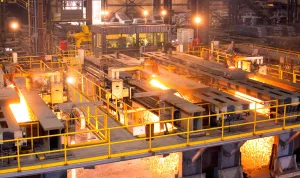Steel Price Trend Monitoring Platforms: Essential Tools for Accurate Market Insights and Strategic Decision-Making in 2024

In the dynamic steel industry, staying ahead of price fluctuations is crucial for businesses and investors. Steel price trend monitoring platforms offer vital tools for tracking market trends, analyzing price movements, and making informed decisions. This guide provides an in-depth look at the top steel price trend monitoring platforms available in 2024, their key features, benefits, and how they can help you navigate the complexities of the steel market.
What Are Steel Price Trend Monitoring Platforms?
- Definition and Purpose
- Definition: Steel price trend monitoring platforms are specialized software solutions designed to track and analyze fluctuations in steel prices. These platforms provide real-time data, historical trends, and predictive analytics to help users make strategic decisions.
- Purpose: The primary goal of these platforms is to offer actionable insights into price movements, enabling businesses to optimize procurement strategies, manage costs, and mitigate risks associated with market volatility.
- Key Features of Monitoring Platforms
- Real-Time Data: Access to live price updates ensures users are informed of current market conditions and can react promptly to changes.
- Historical Analysis: Platforms provide historical price data and trend analysis, allowing users to understand past market behaviors and forecast future trends.
- Predictive Analytics: Advanced analytics and forecasting models help users anticipate future price movements based on historical data and market indicators.
- Customizable Alerts: Tailored alert systems notify users of significant price changes, trends, or market events relevant to their specific needs.
Top Steel Price Trend Monitoring Platforms for 2024
- SteelBenchmarker
- Overview: SteelBenchmarker is a leading platform known for its comprehensive steel price assessments and market analysis.
- Features: Provides real-time price benchmarks, detailed market reports, historical data, and trend analysis. Users can access global and regional price trends for various steel products.
- MEPS International
- Overview: MEPS International offers a global perspective on steel prices with a focus on accurate market data and forecasts.
- Features: Includes real-time updates, market reports, and in-depth analysis of price trends across different regions. MEPS provides detailed insights into market dynamics and price movements.
- Platts Steel Price Index
- Overview: The Platts Steel Price Index is renowned for its reliable steel price assessments and market commentary.
- Features: Offers real-time price indices, historical data, and market analysis. The platform provides comprehensive coverage of various steel products and regions, making it a valuable tool for market intelligence.
- CRU Group
- Overview: CRU Group provides extensive steel market analysis and price monitoring services.
- Features: Features include detailed market analysis, price indices, and forecasts. CRU Group’s platform is known for its in-depth research and industry expertise, offering valuable insights into steel market trends.
Benefits of Using Steel Price Trend Monitoring Platforms
- Enhanced Decision-Making
- Informed Choices: Access to accurate and up-to-date data helps businesses make informed decisions regarding procurement, pricing strategies, and supply chain management.
- Strategic Planning: Predictive analytics and trend analysis support long-term strategic planning and budget management, enabling businesses to anticipate and respond to market changes effectively.
- Risk Management
- Mitigating Volatility: By monitoring price trends and receiving timely alerts, businesses can mitigate the risks associated with price volatility and avoid unexpected costs.
- Competitive Advantage: Staying informed about market conditions and price movements provides a competitive edge, allowing businesses to negotiate better terms and optimize their operations.
- Cost Efficiency
- Budget Management: Accurate price monitoring aids in managing budgets and forecasting costs, ensuring that businesses can plan for price fluctuations and avoid financial surprises.
- Supplier Negotiations: Up-to-date pricing information enables businesses to negotiate more favorable terms with suppliers and optimize procurement strategies.
Best Practices for Using Steel Price Trend Monitoring Platforms
- Integrate with Business Systems
- ERP Integration: Integrate monitoring platforms with Enterprise Resource Planning (ERP) systems to streamline data management and enhance decision-making across various business functions.
- Data Consolidation: Ensure that data from monitoring platforms is consolidated with other business data to provide a comprehensive view of market conditions and financial impacts.
- Customize Alerts and Notifications
- Tailored Alerts: Set up customized alerts based on specific price thresholds, market conditions, or events. This ensures that users receive relevant and timely information tailored to their business needs.
- Regular Reviews: Regularly review and update alert settings to reflect changes in market conditions and business requirements.
- Regularly Analyze and Interpret Data
- Trend Analysis: Utilize the platform’s analytical tools to interpret trends and identify patterns. Understanding historical data and forecasting future trends helps in making informed decisions.
- Expert Insights: Complement data-driven analysis with insights from industry experts to validate trends and gain additional perspectives on market dynamics.
Future Trends in Steel Price Trend Monitoring Platforms
- Advanced AI and Machine Learning Integration
- AI-Powered Analytics: The integration of artificial intelligence (AI) and machine learning will enhance the accuracy of predictive analytics and trend analysis, providing deeper insights into market dynamics.
- Automated Insights: AI-driven platforms will offer more automated and accurate forecasting models, reducing manual effort and improving decision-making processes.
- Increased Automation and Customization
- Automated Reporting: Future platforms will feature greater automation in reporting and analysis, providing users with more timely and actionable insights.
- Enhanced Customization: Advanced customization options for alerts, reports, and data visualization will allow users to tailor the platform to their specific needs and preferences.
Conclusion
Steel price trend monitoring platforms are essential tools for navigating the complexities of the steel market in 2024. By leveraging advanced features, real-time data, and predictive analytics, businesses can stay informed about price movements, manage risks, and make strategic decisions with confidence. Adopting best practices and staying abreast of future trends will ensure that you remain competitive and well-prepared in an ever-evolving market environment.



